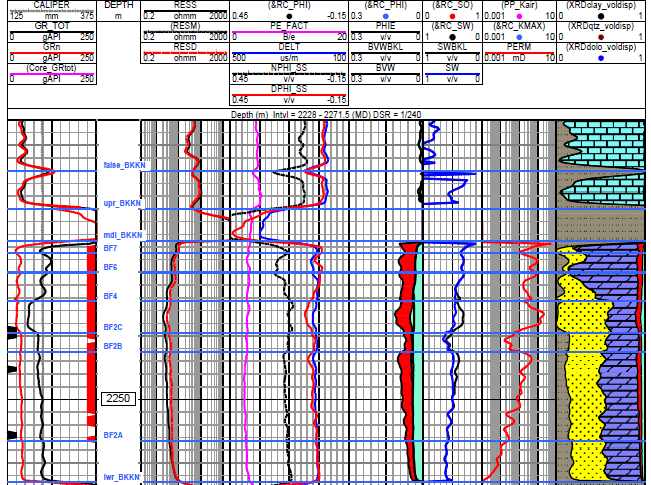|
 LOG NORMALIZATION
BASICS
LOG NORMALIZATION
BASICS
Log normalization is based on the concept that
maximum and
minimum log readings in a zone in an area should have the same log
reading. The assumption includes the fact that there are no major geological reasons
for the values to vary across space.
Reasons for log normalization are numerous: poor tool
calibration, mis-labeled scales, unconventional units of
measurement, mud weight, borehole size, temperature, rock
alteration, and many more.
Log normalization is the process of re-scaling a log so that it
matches its neighbours, based on some logical reasoning. Log
normalization involves a
"stretch" or "squeeze" of the data values between two scale end
points or between two arbitrary log values. The math is shown in a
later Section on this webpage.
Log re-scaling
is a simplified form of normalization. It can involve an equal linear shift of the two scale end-points, or
applying a multiplication factor to all data points.in the
log curve. This is often needed to change older log curve
scales to match modern logs or to convert Metric scales to
English units and vice-versa.
For example,convert gama ray in units of ug-ra-equiv/ton to
API units:
1: GRapi = GRug-ra * 10
Convert neutron porosity from limestone to sandstone units:
2: PHIN_SS = PHIN_LS + 0.03
Convert somic log from English to Metric units:
3: DTCmetric = DTCenglish * 3.281
Re-scaling a resistivity log is a little trickier since the
tools actually measures comductivity, so we need to create a
COND curve from RESD:
4: COND = 1000 / RESD
Adlust the somde error by adding or subtracting a few
milliSermens from COND. This will stretch or squeeze the
high resistivity and do almost nothing to the low
resistivity.
5: CONDnew = COND + X
where X = sonde error correction
Convert COND back to RESD:
6: RESDnew = 1000 / CONDnew
Log normalization is most often applied to gamma
ray logs. Here we re-scale the GR logs so that a particular
clean sand in all wells have the same GR value. Likewise, the key
shale zones in all wells have the same GR value. This makes
correlation of zones easier and helps the analyst to better
understand reservoir quality without additional calculations.
The technique is widely used for sonic, density, density porosity,
and neutron logs. In these cases, the equation is the same but the
MIN and MAX terms apply
to low and high log readings chosen in particular geological
horizons, for example in a low porosity and a shale interval.
Another approach is to run a statistical analysis over the same
geological interval in many wells, select the wells with similar
min, max, and median values as "key" wells, then shift the outlier
logs so that the median matches the key wells.
 CAUTION: Normalization can remove natural geological
variations that may have significance in understanding the
reservoir variations across space. For example, if calcite
cement varies from place to place, normalization will remove
porosity trends that vary with cementation. Similarly, on a
GR log if feldspar content or clay type varies, this
knowledge will be lost.
CAUTION: Normalization can remove natural geological
variations that may have significance in understanding the
reservoir variations across space. For example, if calcite
cement varies from place to place, normalization will remove
porosity trends that vary with cementation. Similarly, on a
GR log if feldspar content or clay type varies, this
knowledge will be lost.
 NORMALIZATION WITH CONSTANT OFFSET
NORMALIZATION WITH CONSTANT OFFSET
The equation is:
1: XXXn = XXX + SHIFT
Where:
XXXn = normalized XXX log value
XXX = input XXX log curve value
SHIFT = value that moves the median curve value in this zone in
this well to the median value
of the key wells.
 COMMENTS
COMMENTS
This method is helpful when neutron log scale (Sandstone vs
Limestone) is unknown or ambiguous. Can be applied to any porosity
log or the logarithm of resistivity. Not recommended for GR or SP..
 Numerical Example
Numerical Example
Median sonic log value over selected interval in Key wells is DTCavg
= 225 usec/m.
Median sonic log value over selected
interval in THIS well is DTCavg = 221 usec/m.
SHIFT = 225 - 221 = +4 usec/m.
DTCn = DTC + 4
 NORMALIZATION By STREtCH or SQUEEZE
NORMALIZATION By STREtCH or SQUEEZE
The equation is:
1: XXXn = XXXMIN + (XXXMAX - XXXMIN) * (XXX -
XXXLOW)
/ (XXXHIGH - XXXLOW)
Where:
XXXn = normalized log value
XXX = input log curve value
XXXMIN = minimum XXX log value to normalize to
XXXMAX = maximum XXX log value to normalize to
XXXLOW = actual XXX log value in this zone in this well that corresponds
to XXXMIN
XXXHIGH = actual XXX log value in this zone in this well that corresponds
to XXXMAX
 COMMENTS
COMMENTS
This is the method most used for GR and SP curves but can be used
with care on any log curve.
 Nunerucak Example Nunerucak Example
Assume you want to re-scale all GR logs so that all clean lines are
at 20 API units and all shale lines are at 120 API units. That makes
GRMIN = 20 API units, GRMAX = 120 API units for all wells
Assume GRLOW = GR0 = 30 API units, GRHIGH = GR100 = 155 API units in
THIS zone in this well.
Assume actual GR at a depth level = 55 API units
1: GRn = 20 + (120 - 20) * (55 - 30)
/ (155 - 30) = 40 API units

Red curve in Track 1 is normalized GR (GRn), black curve is
original gamma ray in a radioactive sand. Because uranium content is
nearly constant, we can re-scale the total GR to a more useful shale
indicator by normalizing. Parameters used were GRMIN = 25, GRMAX =
275, GRLO = GR0 = 100, GRHIGH = GR100 = 350
(off scale but available from LAS file).
|

